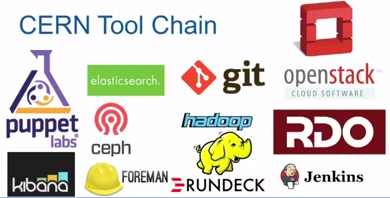This article is more than 1 year old
CERN: 2015 restart causes tech rethink
OpenStack helps LHC boffins cope with predicted 400 PB / year firehose
Vid Going beyond “seeing” the Higgs boson to “understanding” it is going to cause a data flood for CERN researchers, and its infrastructure services manager Tim Bell says that's pushed the outfit to increasingly look beyond its own iron.
Speaking to the OpenStack summit in Paris, Bell says the challenges even of the old Large Hadron Collider data flood was considerable. The LHC experiments have created a 100 petabyte archive (27 PB of which was added this year).
To deal with that, the organisation has 11,000 servers, 75,000 disk drives and 45,000 tapes (because the data needs a 20 year lifespan).
The twice-the-energy upgrade is going to ramp that up even further, Bell said, so that by 2023, the organisation will need around fifty times as much compute, and will need to store 400 PB a year.
There's no hope of achieving that on its own. Already, Bell told the conference, “from a computing point of view, we're actually no longer leading edge.”

CERN's toolkit, from Tim Bell's presentation
Under constraints of budget, data centre capacity, staff, and a fixed time window, CERN has set up collaborations. Chief of these is a “child cell” in Budapest, Hungary, with dual 100 Gbps links back to Geneva.
That, Bell told the conference, is where OpenStack has come into play. Its implementation, tested from 2011 and live from 2013 based on the Grizzly release, presents users with what looks like a single machine.
“[Users] want to click on the interface get a cup of coffee and come back to a working system,” Bell explained. Moreover, users expect their VMs to have continuity, no matter what changes are made in the back end.
The current status of the CERN OpenStack cloud is around 75,000 cores on more than 3,000 servers, with three other instances totalling 45,000 cores, and the group expects to pass 150,000 cores by Q1 2015.
CERN's other key plan is to use OpenStack to create federated clouds that will include not only other academic institutions, but increasingly, public cloud.
Bell highlighted work with RackSpace that arose out of discussions in 2013, with the two organisations developing code (now in production) to let people deploy federated identity on OpenStack.
Bell's presentation video is above. ®
